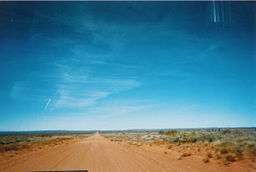Tanami Desert
| Tanami | |
| Desert | |
 Desert track, 2004 | |
| Country | Australia |
|---|---|
| State | Western Australia, Northern Territory |
| Area | 184,500 km2 (71,236 sq mi) |
| Biome | Desert |
 The IBRA regions, with Tanami highlighted in red | |
The Tanami Desert is a desert in northern Australia situated in the Northern Territory and Western Australia.
It has a rocky terrain with small hills. The Tanami was the Northern Territory's final frontier and was not fully explored by Australians of European descent until well into the twentieth century. It is traversed by the Tanami Track.
The name Tanami is thought to be a corruption of the Walpiri name for the area, "Chanamee", meaning "never die". This referred to certain rock holes in the desert which were said to never run dry.
Under the name Tanami, the desert is classified as an interim Australian bioregion, comprising 25,997,277 hectares (64,240,670 acres).[1][2][3]
Biological resources
According to government commissions, the Tanami desert is uniquely "one of the most important biological areas to be found in Australia particularly as it provides refuge for several of Australia's rare and endangered species."[4][5]
The species that are found include:
- Western chestnut mouse (Pseudomys nanus)
- Little native mouse (Pseudomys delicatulus)
- Long-tailed planigale (Planigale ingrami)
Significant bird species include:
- Grey falcon (Falco hypoleucos)
- Australian painted snipe (Rostratulas)
- Freckled duck (Stictonetta naevosa)
Local indigenous groups
The Tanami Desert is Kukatja and Walpiri country. The Tjurabalan live at the edge of the desert.[6]
Southern Tanami Indigenous Protected Area
In July 2012, 10,000,000 hectares (25,000,000 acres) of the desert area (38% of the total bioregion) was declared an indigenous protected area or conservation zone.[7][8][9][10][11]
See also
Notes
- ↑ Environment Australia. "Revision of the Interim Biogeographic Regionalisation for Australia (IBRA) and Development of Version 5.1 - Summary Report". Department of the Environment and Water Resources, Australian Government. Archived from the original on 2006-09-05. Retrieved 2007-01-31.
- ↑ IBRA Version 6.1 data
- ↑ "Interim Biogeographic Regionalisation for Australia (IBRA7) regions and codes". Department of Sustainability, Environment, Water, Population and Communities. Commonwealth of Australia. 2012. Retrieved 13 January 2013.
- ↑ Gibson, David F (1986). "A biological survey of the Tanami Desert in the Northern Territory". Technical report 072-9990 (30). Alice Springs: Conservation Commission of the Northern Territory: 79. ISBN 0-7245-0836-8.
- ↑ Morton, S. R; et al. (1995). "Refugia for biological diversity in arid and semi-arid Australia". Biodiversity Series, Paper No. 4. Australian Government: Department of the Environment, Water, Heritage and the Arts. Retrieved 23 March 2012.
- ↑ Elias, Derek J (2001). Golden dreams: people, place and mining in the Tanami desert (Ph.D thesis). Australian National University.
- ↑ "Australia declares Tanami 'largest' conservation zone". BBC News. 11 July 2012. Retrieved 28 January 2013.
- ↑ "Aboriginal desert reserve bigger than Tasmania". Australian Geographic. AAP. 11 July 2012. Retrieved 28 January 2013.
- ↑ Horn, Allyson (10 July 2012). "Traditional owners to manage conservation zone". ABC News. Australia. Retrieved 28 January 2013.
- ↑ Horn, Allyson (10 July 2012). "Australia's largest conservation zone declared" (transcript). Lateline. Australia: ABC1. Retrieved 28 January 2013.
- ↑ "Southern Tanami declared a conservation zone" (Press release). Central Land Council. 10 July 2012. Retrieved 28 January 2013.
References
- Kelly, Kieran, (2003) Tanami : on foot across Australia's desert heart Sydney : Pan Macmillan Australia, 2003. ISBN 0-7329-1188-5
- Thackway, R and I D Cresswell (1995) An interim biogeographic regionalisation for Australia : a framework for setting priorities in the National Reserves System Cooperative Program Version 4.0 Canberra : Australian Nature Conservation Agency, Reserve Systems Unit, 1995. ISBN 0-642-21371-2
External links
Coordinates: 20°S 130°E / 20°S 130°E